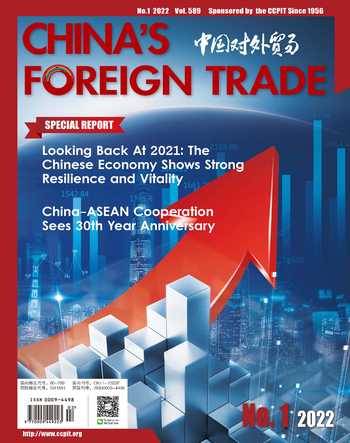The Pursuit of Common Prosperity for People’s Well-being
By Audrey Guo
Since “Peoples lives are better off, comprehensive development of the people and common prosperity of all the people to achieve more obvious substantive progress” has become the vision of 2035, “common prosperity”will become one of the core pieces of work of the current and future years.
What is common prosperity?
At the 10th Meeting of the Financial and Economic Commission of the CPC Central Committee held on August 17, 2021, it was proposed to adhere to the people-centered development philosophy, promote common prosperity through high-quality development, strike a proper balance between efficiency and equity, and establish basic institutional arrangements for coordinating primary, redistribution and tertiary distribution. Intensify tax, social security and transfer payments, and improve the precision, enlarge the proportion of middle-income groups, increase the income of low-income groups, properly regulate high income groups and ban illegal income to form a distribution structure with large middle-income groups and small groups of low income and high income. This will promote social equity and justice, promote the all-round development of people and make all people solidly work towards the goal of common prosperity.
The Meeting has further clarified the connotation and requirements of common prosperity, and stressed common prosperity shall touch all people, not just a few people. Common prosperity is not uniform egalitarianism, clearly putting forward “basic institution- al arrangements for coordinating primary, redistribution and tertiary distribution”, and stressing the need to strive to expand the scale of middle-income groups, will encourage more low-income people to join the middle-income group.
The central government has stressed on many occasions that“common prosperity” does not mean“simultaneous prosperity”. Instead, it means “allowing some people to get rich first, and at the same time supporting and helping other people to get rich later, with the emphasis on encouraging these who work hard, operate legally and dare to start their own businesses”. To achieve the goal of common prosperity, we must first make the “cake” bigger and better through the joint efforts of the people of the whole country, and then cut the “cake” well and distribute it well through reasonable institutional arrangements.
Xie Fuzhan, President of the Chinese Academy of Social Sciences, pointed out in an article that we should do our best and do what we can to explore common prosperity.“We need to step up efforts and take more concrete measures on the most immediate and practical issues that concern people most. We need to move forward at each juncture of time to achieve the goal, and realize the requirements and strategic arrangements set forth by the CPC Central Committee step by step. At the same time, we need to learn from the experience of some countries that have gone beyond the level of development to extend welfare benefits, resulting in inadequate balance between equity and efficiency, and affecting economic development and equitable distribution.”
At the same time, the meeting pointed out that promoting common prosperity for all people is an ardu-ous and long-term task, which cannot be fully implemented in a short period of time. It is urgent to select some regions with relatively favorable conditions to a conduct pilot run and set an example.
On June 10, 2021, the CPC Central Committee and State Council issued the Opinions on Supporting the High-Quality Development and Construction of Common Prosperity Demonstration Zone in Zhejiang, marking that Zhejiang took the lead in the construction of common prosperity demonstration zone.
Zhejiang is one of the areas with the smallest gap between the urban and rural areas in China, and the province also started the deployment of common prosperity earlier. At the two sessions of Zhejiang Province in January 2021, Zhejiang began to deploy this years work of common prosperity, which was incorporated into the provinces “14th Five-Year Plan”.
Yuan Jiajun, Zhejiang Provincial Party Secretary believes that common prosperity is not only a concept of social development, but also a social reform marked by narrowing the regional, urban-rural and income gaps. Zhejiang is one of the provinces with the most balanced development between the urban and rural areas, the richest people, the strongest social vitality and the best social order, which has laid a solid foundation for the demonstration of common prosperity in Zhejiang.
Enterprises contribute to common prosperity
Enterprises are an indispensable force to promote Chinas economic development and may play an important role in the process of realizing common prosperity. Facing the goal of common prosperity, more and more enterprises actively respond to participate in the realization of common prosperity.
On June 25, 2021, Geely launched the common prosperity plan, including a series of measures such as stock ownership plan to raise income, vocational education and development, childrens school enrollment and childcare, family medical insurance, welfare housing and car purchasing, as well as cultural and sports facilities construction. In addition, Geelys common prosperity plan also includes helping to build a more perfect Ningbo auto industry ecological system to achieve the common prosperity of the industry.
On August 18, 2021, Tencent announced that apart from the RMB 50 billion to kick-start a sustainable social value innovation strategy, another RMB 50 billion will be added to initiate a special plan for common prosperity. By virtue of its own digital and technology capabilities, Tencent will provide continuous power to the areas of peoples livelihood, such as revitalizing rural areas, raising income for low-income groups, improving the primary medical care system and striking balanced development of education.
In Alibabas plan, ten initiatives to promote common prosperity include: intensifying investment in science and technology to support digitalization in underdeveloped areas; supporting the growth of micro, small- and medium-sized enterprises; boosting the construction of agricultural industrialization; supporting small- and medium-sized enterprises to go overseas; supporting high-quality employment; helping to improve the welfare of flexible workers; promoting equal digital life in the urban and rural areas; narrowing the digital divide and strengthen services and protection for the vulnerable; supporting the improvement of primary health care capacity; setting up a special development fund and a total of RMB 100 billion will be invested by 2025 to boost common prosperity.
Liu Qingfeng, Chairman of iFLYTEK said that promoting common prosperity has two important core goals: the first is high-quality development, which is the foundation of achieving common prosperity; the second is high-quality life, which is a goal of achieving allround development. The booming development of artificial intelligence technology has created unprecedented conditions and opportunities for achieving common prosperity.
Take iFLYTEK as an example. At present, the “AI+ Medical” project has covered 30,000 medical institutions in 240 districts and counties across the country, providing 290 million auxiliary diagnoses. In Fujian Province, the diagnostic rationality rate reached 90%, the standard of electronic medical records reached 80%, and 510,000 people have been assisted in diagnosis. Take AI digital employees as an example. “AI+RPA”may greatly improve the production and operation efficiency of the enterprises, automate more than 45% of the work, and realize digital transformation and upgrading from production process automation to operation and management automation.
Yuan Gangming, a researcher at the China Institute for Economic Thought and Practice at Tsinghua University, said: “It is a very good practice for private enterprises to get rich first and then establish a common prosperity fund to help the weak links in Chinas regional and industrial economy to get rich afterwards.”
Yuan believes that to promote the realization of the goal of common prosperity, the countrys macro policies will inevitably have some aspects that are difficult to reach, and it is very beneficial for enterprises to make supplement through the third time allocation.
Give full play to the role of tertiary distribution of charity
Since the 18th CPC National Congress, Chinas philanthropy has made remarkable progress. According to the Ministry of Civil Affairs, by the end of 2020, China had more than 900,000 registered social organizations, 9,480 registered charitable organizations, with net assets of nearly RMB 200 billion and 209 million registered volunteers. Charity has become an integral part of poverty alleviation, disaster relief and assistance to those who need additional support.
Industry experts and scholars surveyed generally believe that to fully leverage the regulatory potential of the tertiary distribution and form a strong philanthropic support, we need to further improve transparency, credibility and professionalism of charitable organizations, and push Chinas philanthropy into a stage of high-quality development.
Tang Min, a state Council counsellor and Vice Chairman of the China Social Entrepreneur Founda- tion, said that the tertiary distribution, which is redistributed through non-compulsory means such as individual donations, has great potential in promoting common prosperity.
In recent years, some places across the country have witnessed rapid development of charitable undertakings, improved policies and systems, and increased influence of charitable and public welfare projects. For instance, since the promulgations and implementation of Chinas first Charity Law as of 2016, Zhejiang Province has successively issued the countrys first provincial laws and regulations in the field of charity and the Implementation Opinions on Accelerating the High-Quality Development of Charity, providing a strong institutional guarantee for the healthy and sustainable development of charity.
Wang Huiyao, Director of the Center for China and Globalization(CCG), suggested that increasing tax incentives for individual and corporate donations, improving relevant laws and regulations, and encouraging the creation of a favorable atmosphere for public welfare. At the same time, we will severely crack down on illegal activities, such as tax evasion and donation fraud by enterprises and individuals manipulating charity, to maintain the credibility of charities.
In recent years, online relief platforms such as Shuidichou and Qingsongchou have become an important choice for public charity, and information networks have played an important role in helping help those in distress.
“In the past, when information was not transparent, people donated money to charity organizations, but they didnt know how or where the money would be used. Even if people are willing to donate, they are still concerned about the lack of credibility of charity organizations,” said Rao Jinxing, President of the Shenzhen Institute of Social Organization. And technological progress has revolutionized the whole process of public charity and digital means can be used to track the usage and effect of donations in real time.
On the other hand, open and transparent supervision channels should be established to accept supervision from the government, public opinion, individual citizens and social media to enhance the credibility of charitable organizations.
In recent years, various cities and counties in Anhui Province realized accurate delivery through the government website, e-government service platform, flexible use of new media in government, news media, mobile phone text messages, bulletin board, pamphlets, letters, and“official and easily understood document” to ensure that the people can see, understand and supervise. This will promote information sharing and data open in the construction of social public welfare.
- China’s foreign Trade的其它文章
- Looking Back At 2021:The Chinese Economy Shows Strong Resilience and Vitality
- CCPIT Work Meeting 2021 Is Held Virtually in Beijing
- Joint Effort to Resolve Disputes in Intellectual Property Rights
- Six Industry Opportunities As A Result of Population Change
- Demands for Coal-fired Power Will Reach New High
- IDC’s Top 10 Predictions on China’s ICT Market In 2022

